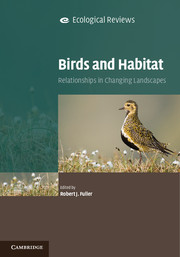Book contents
- Frontmatter
- Contents
- List of Contributors
- Preface
- Part I The complexity of patterns and processes
- Part II Case studies of habitat use and selection
- Part III Wider perspectives
- Chapter Fifteen What is habitat quality? Dissecting a research portfolio on shorebirds
- Chapter Sixteen Understanding individual life-histories and habitat choices: implications for explaining population patterns and processes
- Chapter Seventeen Insufficient adaptation to climate change alters avian habitat quality and thereby changes habitat selection
- Chapter Eighteen Australian birds in a changing landscape: 220 years of European colonisation
- Chapter Nineteen Birds in cultural landscapes: actual and perceived differences between northeastern North America and western Europe
- Chapter Twenty Birds and their changing habitat: thoughts on research and conservation strategies
- Species index
- Subject index
- References
Chapter Twenty - Birds and their changing habitat: thoughts on research and conservation strategies
Published online by Cambridge University Press: 05 December 2012
- Frontmatter
- Contents
- List of Contributors
- Preface
- Part I The complexity of patterns and processes
- Part II Case studies of habitat use and selection
- Part III Wider perspectives
- Chapter Fifteen What is habitat quality? Dissecting a research portfolio on shorebirds
- Chapter Sixteen Understanding individual life-histories and habitat choices: implications for explaining population patterns and processes
- Chapter Seventeen Insufficient adaptation to climate change alters avian habitat quality and thereby changes habitat selection
- Chapter Eighteen Australian birds in a changing landscape: 220 years of European colonisation
- Chapter Nineteen Birds in cultural landscapes: actual and perceived differences between northeastern North America and western Europe
- Chapter Twenty Birds and their changing habitat: thoughts on research and conservation strategies
- Species index
- Subject index
- References
Summary
The chapters in this book show that relationships of birds with habitat take many different forms, both across and within species; they are affected by numerous processes and are frequently difficult to predict with accuracy. This concluding chapter draws out some general themes and considers implications for conservation strategies at a time when environmental trends appear to be moving towards greater volatility, disturbance and uncertainty.
Habitat is not a fixed trait
Most species clearly have limits to their potential habitat, though in the case of some generalists, such as the blackbird Turdus merula and the great tit Parus major in western Europe, these limits are set very wide indeed. Nonetheless, within these limits, there are many reasons why patterns of habitat occupancy may differ in space and time. There is always the possibility that what appears different to the human eye represents no real difference to the bird – the essential requirements may be met in very different contexts. Evidence comes from the rapid colonisation by open country and woodland species of ‘novel habitats’ provided by lowland conifer plantations in the twentieth century (Fuller and Ausden, 2008). Equally, evidence now exists of more fundamental plasticity and flexibility in the ways that many birds select and use habitat.
- Type
- Chapter
- Information
- Birds and HabitatRelationships in Changing Landscapes, pp. 516 - 529Publisher: Cambridge University PressPrint publication year: 2012
References
- 2
- Cited by



